Headwater Gold Defines Multiple High-Priority Drill Targets at the Midas North Project, Nevada
Vancouver, British Columbia – TheNewswire – January 23, 2023: Headwater Gold Inc. (CSE:HWG) (OTC:HWAUF) (the “Company” or “Headwater”) is pleased to provide an exploration update on the Midas North project located in Elko County, Nevada. Headwater’s Midas North exploration program is fully funded during the earn-in phase by Newcrest Mining Limited (“Newcrest”), pursuant to the earn-in agreement announced on August 16, 2022.
Highlights
- Headwater has defined multiple high-priority drill targets located directly on trend north of Hecla Mining Company’s (“Hecla”) past producing Midas high-grade mine complex;
- The Company interprets the project to represent a fully preserved epithermal system with potential for high-grade mineralization at depth below broad areas of favourable alteration;
- CSAMT geophysical surveys have identified several high-resistivity zones interpreted to represent silicification and possible feeder structures;
- Radiometric survey results show both a broad radiometric low and linear radiometric highs interpreted to represent structurally controlled zones of alteration potentially associated with mineralized epithermal feeder structures;
- An aeromagnetic survey has highlighted several linear magnetic lows interpreted as corridors of structurally controlled mag-destructive alteration which may also indicate feeder structures at depth; and,
- A final drill plan is currently being developed for a multi-rig maiden drill program scheduled to commence in Q2.
Caleb Stroup, the President and CEO of the Company, states: “Since signing the earn-in agreement with Newcrest in August 2022, we have been building an extensive geological and geophysical dataset at Midas North. The goal has been to apply the very best geoscientific tools available to identify feeder structures which have the potential to host high-grade epithermal gold-silver mineralization at depth below the extensive zone of alteration observed at surface. In aggregate, the geophysical studies have done a phenomenal job of helping the Company understand the subsurface geology and have been instrumental in identifying several high-priority target areas for drill testing in the upcoming field season. The Midas mine complex located immediately to the south serves as a clear geologic analog, with over two million ounces of gold and over 25 million ounces of silver historically produced from high-grade epithermal veins at Midas between 1998 and 2019(1 2) by operators such as Franco-Nevada, Newmont and Hecla.”
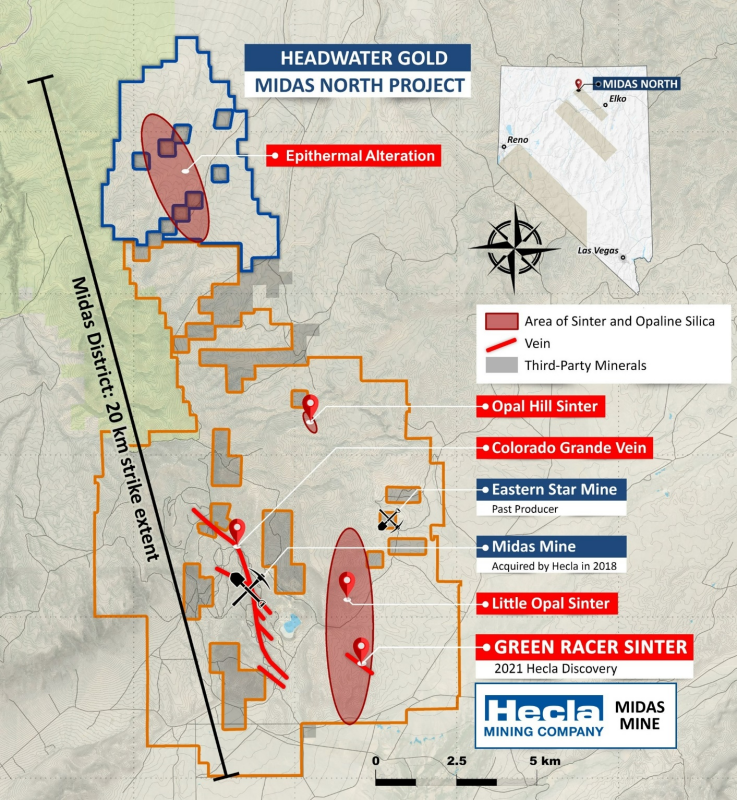 Figure 1: Map of the Midas high-grade vein district in northern Nevada. Headwater Gold’s Midas North project adjoins Hecla’s past producing Midas Mine complex, encompassing another large epithermal alteration cell north along the trend of the Midas Mine.
Figure 1: Map of the Midas high-grade vein district in northern Nevada. Headwater Gold’s Midas North project adjoins Hecla’s past producing Midas Mine complex, encompassing another large epithermal alteration cell north along the trend of the Midas Mine.
Midas North Geophysical Surveys:
The results of the geophysical surveys confirm the utility of using magnetics, radiometrics, gravity and CSAMT resistivity, together with geology, to generate high-quality drill targets at Midas North below the broad area of favourable epithermal alteration outcropping at surface.
The 2022 geophysical programs consisted of:
- A controlled-source audio-frequency magnetotelluric (“CSAMT”) resistivity survey totalling 36.3 line-kilometres (“line-km”) on eight parallel 400 metre (“m”) spaced profiles;
- Helicopter airborne magnetic and radiometric surveys totalling 357 line-km completed at 100 m spacing totalling 32.5 km; and,
- A ground gravity survey consisting of 767 stations on a 200 m grid to 400 m grid regionally, with a total survey footprint of 114 km
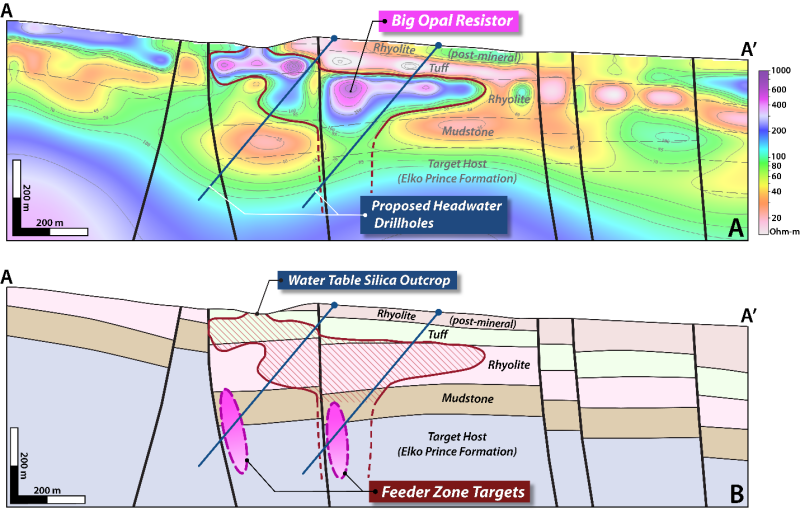 Figure 2: (A) CSAMT geophysics apparent resistivity profile with (B) Headwater’s working geological model and preliminary drill targets in the Big Opal target area. See Figure 3 for plan map indicating the CSAMT line position and geological cross section location.
Figure 2: (A) CSAMT geophysics apparent resistivity profile with (B) Headwater’s working geological model and preliminary drill targets in the Big Opal target area. See Figure 3 for plan map indicating the CSAMT line position and geological cross section location.
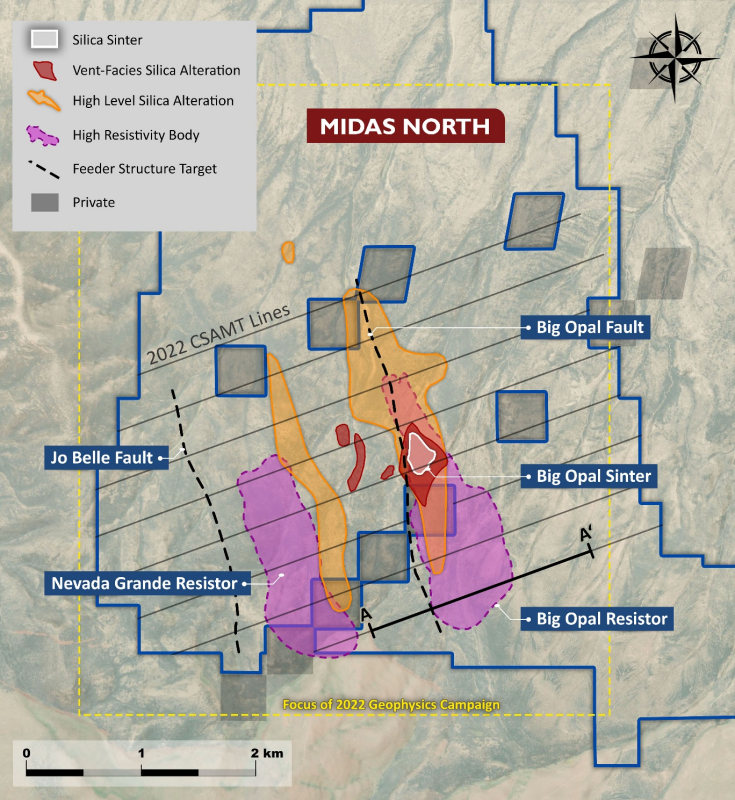
Figure 3: Midas North property map highlighting the principal alteration zones, target areas and approximate geophysical survey footprints shown in detail in Figures 5, 6 and 7.
Geophysical Targets Areas:
Headwater has identified multiple drill targets by analyzing the multi-parameter geophysical data described above. The principal targets contain geophysical and geological characteristics indicating potential to host kilometre-scale feeder zones at depths of 200m to 400m below the outcropping mapped sinters and other high-level hot-spring-type alteration mapped at surface.
The principal targets are interpreted as follows:
- Big Opal Sinter Target NNW-striking sub-vertical resistivity break beneath outcropping vent facies sinter deposits with interpreted mafic sill at depth. Strong geological similarities to Hecla’s recent Green Racer Sinter vein discovery on the adjacent Midas Mine complex.
- Big Opal Fault Target Kilometre-scale NNW-striking resistivity break at the margin of a large resistivity high (Big Opal Resistor) interpreted as a thick water table silica blanket.
- Big Opal Resistor Target: High-angle resistivity break beneath the Big Opal Resistor.
- Jo Belle Fault Target District-scale fault associated with kilometre-scale, strongly resistive CSAMT feature (Nevada Grande Resistor). The stratigraphic offset and fault orientation are considered geologically comparable to the high-grade Colorado Grande vein in the main Midas district. Strong illite-adularia alteration is interpreted from a NNW-trending radiometric high (potassium channel) along the fault trace.
- Nevada Grande Resistor Large resistor with approximately 2 kilometres of strike extent in the hanging wall of the Jo Belle fault interpreted to potentially represent a second locus of fluid flux and vein formation separate from the Big Opal structural corridor.
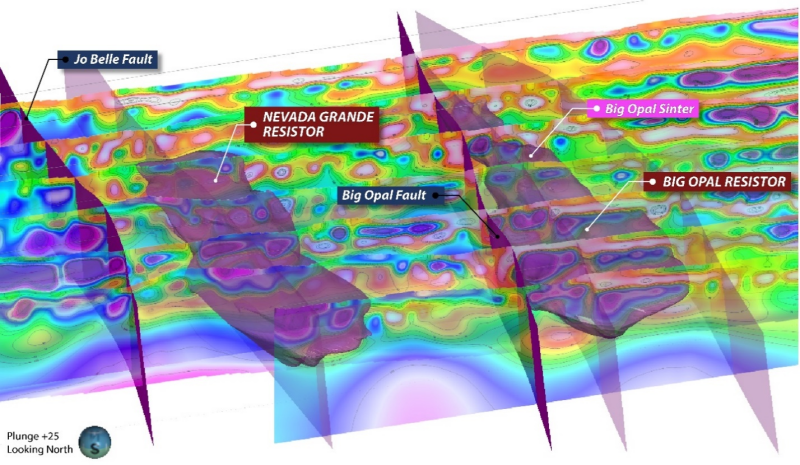 Figure 4: 3D oblique view of CSAMT geophysical profiles, high-resistivity anomalies, interpreted faults and surface alteration features. The resistivity volumes shown are interpreted to represent extensive zones of pervasive silicification with potential for epithermal feeder zones at depth. CSAMT sections are on 400 m spaced lines. See Figure 2 for resistivity scale.
Figure 4: 3D oblique view of CSAMT geophysical profiles, high-resistivity anomalies, interpreted faults and surface alteration features. The resistivity volumes shown are interpreted to represent extensive zones of pervasive silicification with potential for epithermal feeder zones at depth. CSAMT sections are on 400 m spaced lines. See Figure 2 for resistivity scale.
CSAMT Survey
The CSAMT data collected by the Company has proven particularly effective for mapping the subsurface geometries of interpreted silica alteration beneath areas of high-level silica and steam-heated clay alteration, interpreted to represent the upper portion of a completely preserved epithermal system. Multiple high-angle resistivity breaks occur adjacent to and beneath shallow, tabular resistive bodies, each with over 2 kilometres of strike length (Figures 2, 3 and 4).
Airborne Radiometric Survey
Radiometric survey results and potassium data in particular show discrete linear radiometric highs which may represent corridors of illite-adularia alteration that are subparallel to the feeder structures interpreted from the CSAMT data. The potassium data additionally reveal a broad, spatially continuous low coincident with the principal area of strong surface alteration (Figure 5) potentially attributable to a broad zone of argillic alteration.
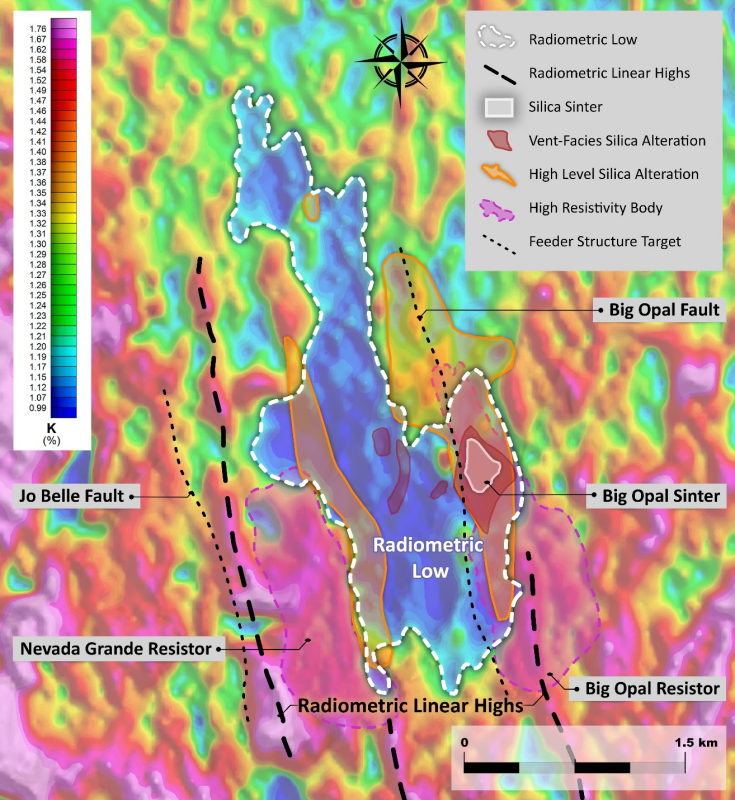
Figure 5: Radiometric survey potassium channel results showing central radiometric low, potentially attributable to extensive clay alteration and discrete linear radiometric highs which may represent structurally controlled zones of illite-adularia alteration.
Airborne Magnetic Survey
Strong contrasts in magnetic response reveal numerous NNW-trending linear magnetic lows, as well as a broad magnetic high in the Big Opal area (Figure 6). The linear magnetic low features are consistent with magnetite-destructive alteration of the host volcanic rocks along structural corridors which potentially focused geothermal fluids. Several discrete magnetic highs elsewhere on the property correspond with outcropping mafic sills. The large, low-amplitude magnetic high is interpreted by Headwater as a possible buried mafic intrusion, analogous in character to the sill-dike complexes spatially and temporally associated with high-grade vein deposits elsewhere in northern Nevada, such as Midas, Hollister, Fire Creek and Mule Canyon1.
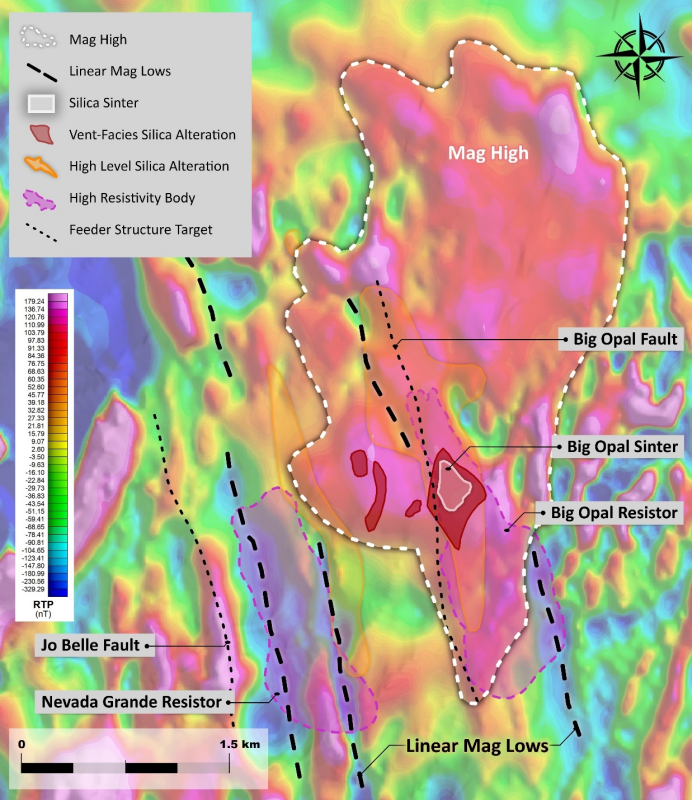
Figure 6: Aeromagnetic geophysical survey highlighting several linear zones of magnetite-destructive alteration interpreted to represent potential feeder structures. The strong magnetic signature beneath the Big Opal Sinter area is interpreted as a possible mafic sill which are common adjacent to the high-grade veins in the historic Midas district and elsewhere in Nevada1.
Gravity Survey
The core of the property is characterized by a broad gravity low which suggests a possible zone of pervasive argillic alteration in the surrounding volcanic host rock. The gravity low broadly overlaps with the footprint of a radiometric low and encompasses the areas of highest intensity alteration mapped at surface. The NNW elongation of the gravity low is consistent with property-wide structural trends detected by other geophysical surveys and surface mapping.
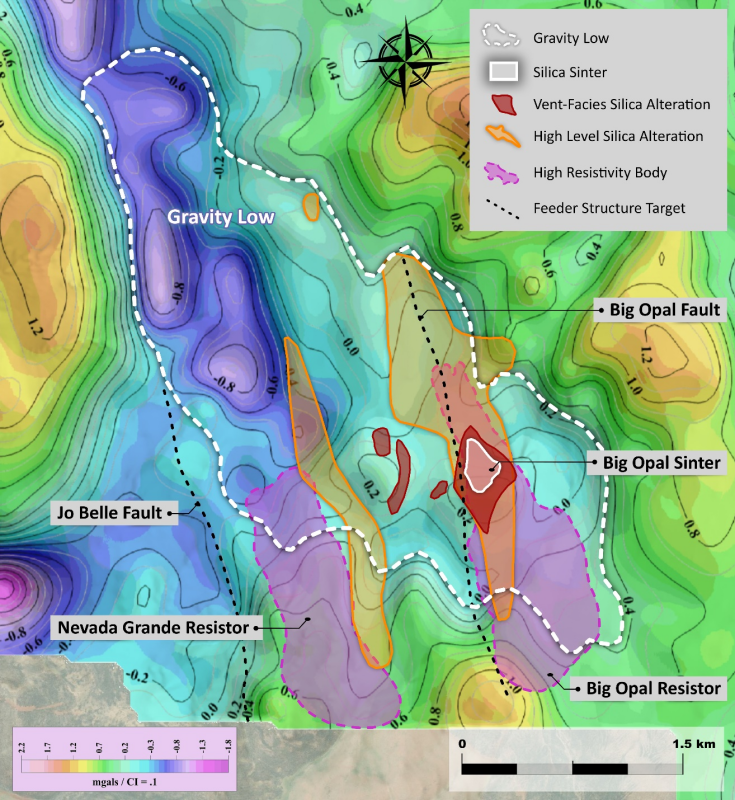
Figure 7: Residual gravity image showing a broad embayment in the central project area interpreted to correspond to the footprint of intense clay alteration.
About the Midas North Project
Headwater’s 100% owned and royalty-free Midas North project in Nevada adjoins Hecla Mining Company’s (NYSE: HL) past producing Midas Mine complex and covers a large hydrothermal alteration cell, extending at least 4 kilometres in strike and 1 kilometre in width. Rock chip and stream sediment samples collected by the Company from the project area have highlighted several priority areas of anomalous precious metal values with highly anomalous values of epithermal pathfinder elements (see Headwater news release dated October 4, 2021). Extensive epithermal alteration exists on the project, including widespread zones of high-level chalcedonic to opaline silica flooding, clay alteration and local sinter formation, including fossilized geyser vents. The project has seen very limited historic exploration with no apparent history exploration drilling. The Company believes the project has potential for high-grade epithermal mineralization at depth similar to that found at Hecla’s adjacent Midas Mine complex1.
Earn-in Agreement with Newcrest
Newcrest is sole funding a firm minimum commitment of US$2,000,000 in exploration expenditures over a two-year period from August 2022 on the Midas North project or will pay the difference to Headwater.
During the staged earn-in phase, Newcrest has the right to earn up to an initial 65% interest in the Midas North project by sole funding exploration expenditures (inclusive of the minimum commitment) of US$30,000,000 over a 6-year period.
Newcrest retains the further right to earn an additional 10% interest in the project (for a total interest of 75%) by ceding a 2% net smelter return royalty to Headwater subject to certain partial buydown rights and completing a Pre-Feasibility Study, solely funded by Newcrest and which includes a minimum 1.5 million ounce gold or gold-equivalent resource within an additional 24-month period.
The Midas North project is one of four Headwater projects under earn-in agreements with Newcrest (see news release dated August 16, 2022 for information on all Newcrest earn-in agreements).
About Headwater Gold
Headwater Gold Inc. (CSE: HWG, OTCQB: HWAUF) is a technically-driven mineral exploration company focused on the exploration and discovery of high-grade precious metal deposits in the Western USA. Headwater is aggressively exploring one of the most well-endowed and mining-friendly jurisdictions in the world with a goal of making world-class precious metal discoveries. Headwater has a large portfolio of epithermal vein exploration projects and a technical team comprised of experienced geologists with diverse capital markets, junior company and major mining company experience. The Company is systematically drill testing several projects in Nevada, Idaho, and Oregon and in August 2022 announced a significant transaction with Newcrest Mining Limited where Newcrest acquired a 9.9% strategic equity interest in the Company and entered into earn-in agreements on four of Headwater’s projects.
For more information, please visit the Company’s website at www.headwatergold.com.
On Behalf of the Board of Directors
Caleb Stroup
President and CEO
+1 (775) 409-3197
For further information, please contact:
Brennan Zerb
Investor Relations Manager
+1 (778) 867-5016
Qualified Person
The technical information contained in this news release has been reviewed and approved by Scott Close, P.Geo (158157), a “Qualified Person” (“QP”) as defined in National Instrument 43-101 – Standards of Disclosure for Mineral Projects.
1 The Midas North project owned by the Company hosts exploration targets with no known resources or reserves. Gold mineralization on Hecla’s adjacent Midas Mine Complex and high-grade vein deposits elsewhere in northern Nevada including Hollister, Fire Creek and Mule Canyon does not indicate similar mineralization is present on the Company’s Midas North project.
2 Goldstrand, P.M., and Schmidt, K.W., 2000, Geology, mineralization, and ore controls at the Ken Snyder gold-silver mine, Elko County, Nevada, in Cluer, J.K., Price, J.G., Struhsacker, E.M., Hardyman, R.F., and Morris, C.L., eds., Geology and Ore Deposits 2000: The Great Basin and Beyond: Geological Society of Nevada Symposium Proceedings, May 15-18, 2000, p. 265-287.
Forward-Looking Statements
This news release includes certain forward-looking statements and forward-looking information (collectively, “forward-looking statements”) within the meaning of applicable Canadian securities legislation. All statements, other than statements of historical fact, included herein including, without limitation, statements regarding future capital expenditures, exploration activities and the specifications, targets, results, analyses, interpretations, benefits, costs and timing of them, Newcrest’s anticipated funding of the earn-in projects and the timing thereof, and the anticipated business plans and timing of future activities of the Company, are forward-looking statements. Although the Company believes that such statements are reasonable, it can give no assurance that such expectations will prove to be correct. Often, but not always, forward looking information can be identified by words such as “pro forma”, “plans”, “expects”, “may”, “should”, “budget”, “scheduled”, “estimates”, “forecasts”, “intends”, “anticipates”, “believes”, “potential” or variations of such words including negative variations thereof, and phrases that refer to certain actions, events or results that may, could, would, might or will occur or be taken or achieved. Forward-looking statements involve known and unknown risks, uncertainties and other factors which may cause the actual results, performance or achievements of the Company to differ materially from any future results, performance or achievements expressed or implied by the forward-looking statements. Such risks and other factors include, among others, risks related to the anticipated business plans and timing of future activities of the Company, including the Company’s exploration plans and the proposed expenditures for exploration work thereon, the ability of the Company to obtain sufficient financing to fund its business activities and plans, the risk that Newcrest will not elect to obtain any additional interest in the Projects in excess of the minimum commitment, the ability of the Company to obtain the required permits, changes in laws, regulations and policies affecting mining operations, the Company’s limited operating history, currency fluctuations, title disputes or claims, environmental issues and liabilities, as well as those factors discussed under the heading “Risk Factors” in the Company’s prospectus dated May 26, 2021 and other filings of the Company with the Canadian Securities Authorities, copies of which can be found under the Company’s profile on the SEDAR website at www.sedar.com.
Readers are cautioned not to place undue reliance on forward-looking statements. The Company undertakes no obligation to update any of the forward-looking statements, except as otherwise required by law.



























